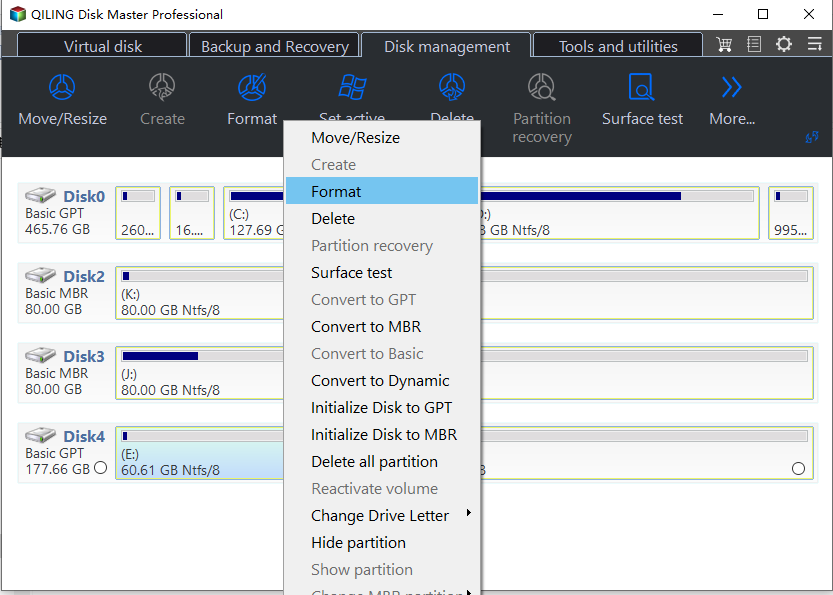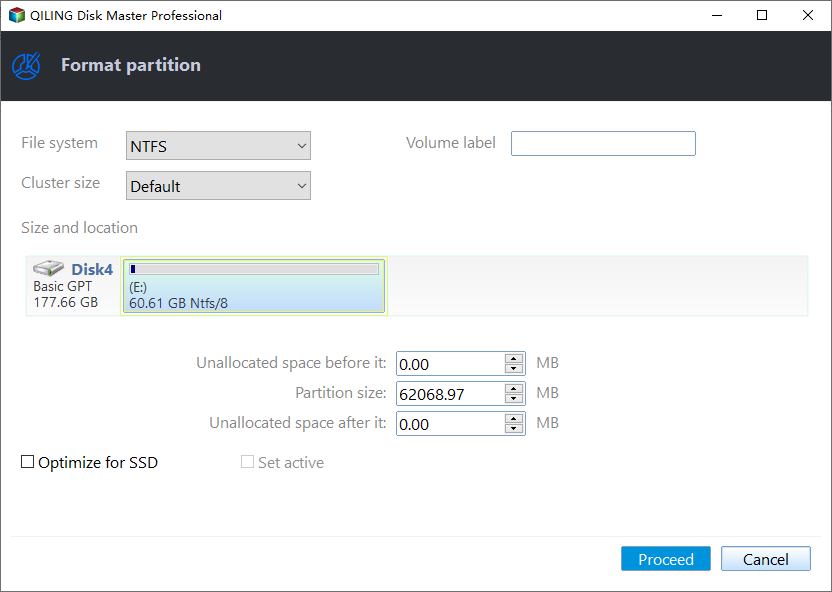How to Format An External Hard Drive That Is Not Visible [Efficient Ways]
Key Takeaways:
- Invisible external hard drives can be caused by hard drive or connection problems. An external hard drive not being visible can cause it not to be formatted.
- You can resolve the invisibility issue by updating the driver, checking the connection, and allowing troubleshooting.
- Then use a professional formatting tool - Qiling Disk Master - to format the external hard drive that is not visible.
An external hard drive is usually used for storing or backing up data. It can be used on Windows PC or PS4, and due to the compatibility of different devices, we need to format the external hard drive. However, when we connect the external hard drive to a Windows PC or other device, you may find that the external hard drive is not visible on the computer. So how to format an external hard drive that is not visible? Qiling gives you a thorough, step-by-step instruction manual:
| ⏱️Duration | 3-5 minutes |
| 🧑💻Difficulty | Easy, suitable for newcomers |
| ⚒️Software Required | Qiling Disk Master |
| 👣Steps |
When ready, read the detailed steps to format an external hard drive That Is Not Visible.
How to Format An External Hard Drive That Is Not Visible
It is normal for an external hard drive to be invisible or undetectable in a PC. Many users have discussed this issue on the forums. Here is a typical example from Tom's Hardware:
How can I format WD 500GB External Hard disk drive that is not visible on my computer? The disk simply shows at the taskbar; it cannot be read; the green light I need to format the drive ... How do I do that since it's not visible. from Tom's Hardware
If you have a similar problem with how to format an external hard drive that is not visible, then this tutorial can be a guide for you. We'll show solutions to help you format an external hard drive without visibility. So let's get started.
Stage 1. Make the External Drive Visible
1. Quick Method
Before applying advanced troubleshooting methods, you can try some quick fixes:
- Reboot your PC and connect the external hard drive to troubleshoot temporary failures or reasons that prevent the hard drive from being detected.
- Connect the hard drive using a different USB port or a different computer.
- If the external hard drive has a dedicated power cable, plug it into a different power outlet or replace it.
If none of these fail, then keep reading to try other fixes.
2. Check and Update the Windows Driver
If Windows Disk Management does not list external drives, you can check for drive problems on Windows through Device Manager. If the drive is outdated or corrupted, you can install a new driver or uninstall the driver and restart your computer.
Step 1. Press "Windows" + "R" and type "devmgmt.msc" to open the Device Manager.
Step 2. Select Disk drivers and check if the external hard drive has a yellow exclamation mark. If it does, then it has a problem.
Step 3. Right-click on the problem drive and select "Properties."
Step 4. Choose to update or uninstall the driver as needed.

3. Run the Troubleshooter
By running Troubleshooting, you can view the hardware and device failures and fix them:
Step 1. Press Windows + R or right-click the Windows icon to open the Run window.
Step 2. Type msdt.exe -id DeviceDiagnostic to open the Hardware and Device Troubleshooter.
Step 3. To start troubleshooting, click Next and adhere to the directions displayed on the screen.

After troubleshooting, you can see if the external hard drive is displayed. After making the external hard drive visible, you can start formatting it.
Stage 2. Format an External Hard Drive
Once the drive becomes visible, you can format the external hard drive in several ways. You can use Windows built-in tools: Disk Management and CMD: right-click on the target disk and select Format external hard drive. However, the command line requires you to be familiar with your computer's commands, and Disk Management will not allow you to format external hard drives larger than 32G.
Here I strongly recommend you choose a professional formatting tool - Qiling Disk Master Free, which breaks the limitations of Windows built-in tools and allows users to easily format external hard drives to NTFS, FAT32, exFAT, and other formats. In addition, it simplifies the formatting process so that you can easily complete it even if you are unfamiliar with computer operations.
After downloading this tool for free, you can follow the below process to format an external hard drive that is not visible.
Step 1. Launch Qiling Disk Master, right-click the partition on your external hard drive/USB/SD card which you want to format and choose the "Format" option.

Step 2. Assign a new partition label, file system (NTFS/FAT32/EXT2/EXT3/EXT4/exFAT), and cluster size to the selected partition.

Step 3. Click the "Proceed" button to start formatting your external hard drive/USB/SD card.

Step 4. In the Warning window, click "Yes" to continue.
Qiling Disk Master also provides functions such as converting NTFS to FAT32. In addition, it also supports resizing and merging partitions. This powerful tool is perfectly suited for your disk management needs.
You May Also Like:
Why External Hard Drive Is Not Visible
There are many reasons why an external hard drive does not show up on your Windows computer; the following are some of the common problems:
- Connection problems due to port failure
- Outdated or corrupted drivers
- The external hard drive is not powered on
- Corrupted system drive
- Partitioning problems with the external drive
These issues can cause the external drive to not appear on the PC. You can make the external drive visible with the solution provided in this article and then format the undetected external drive using Qiling Disk Master.
Conclusion
Do you know how to format an external drive that is not visible after reading this tutorial? If the external drive is not visible, you need to fix the invisible error first. If the external drive cannot be formatted, you can try Qiling Disk Master, which sometimes directly detects external drives that are not detected by Windows and provides a quick formatting solution. In addition, we have provided possible reasons why an external hard drive may not be visible, so you can be on guard the next time you encounter such a problem.
Thanks for reading! Hope this passage can be helpful to you. If you like this tutorial, click the social buttons to share it with others in need.
FAQs About How to Format An External Hard Drive That Is Not Visible
The above is a detailed solution for formatting an external hard drive that is not visible. This section will provide some additional frequently asked questions and answers, so please read on if you are interested:
1. How to repair an external hard drive not detected?
There are many reasons why an external hard drive is not detected, such as file system errors, USB port failure, drive problems, or connection errors. You can do a quick fix as follows:
- Make sure it is plugged in and powered on
- Reboot the computer
- Try another cable, port, or PC
- Format the drive
- Update the drivers
- Clean up the disk
2. Why is the external hard drive not showing up in Disk Management?
Several reasons may cause the external hard drive not showing up in Disk Management. Your Windows computer may not be able to detect an attached external hard drive for the following reasons:
- Unstable or poor connection
- A damaged hard drive
- Wrong drive letter
- Hidden hard drive
- Outdated driver
3. Can I format the external hard drive when not recognized?
Of course, you can format the external hard drive when not recognized. But you need to repair it first:
If the external hard drive is not recognized, it is probably a connection problem. You can make the external hard drive visible by replacing the USB port or cable.
Then use Windows built-in tools - Disk Management, right-click on the target disk, and select Format.
Related Articles
- Wyze Cam SD card Format: How to Format SD Card for Wyze Cam?
- How to Wipe SSD for Reuse in Windows 11/10/8/7
- Fix 'Invalid Partition Table' Error Dell Computers [100% Working]
- How to Fix USB Flash Drive Not Showing Up in Windows 11🔥